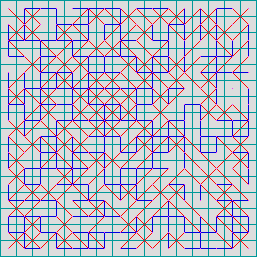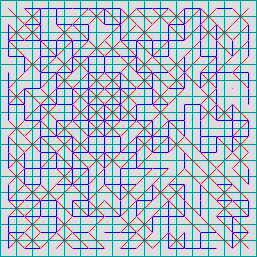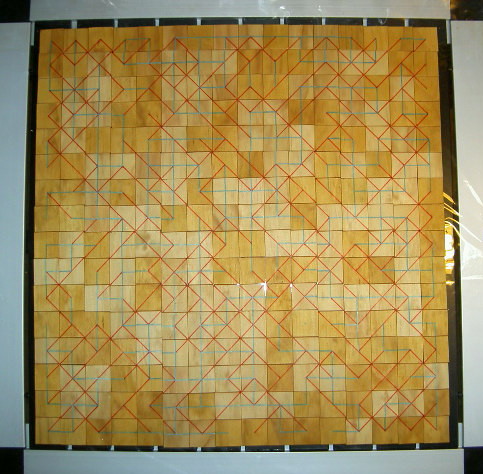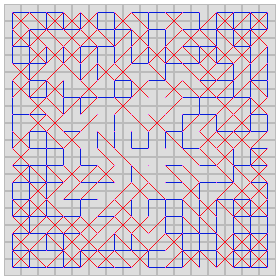After Martin's discovery of the China Labyrinth, for which he also coined the name, I did for squares (16 pieces), triangles (2x8 pieces) and cubes (64 pieces), what Martin had conceived for hexagons.
The sets involved now also allowed 'compact' solutions, a concept Martin had missed because in envisioning a 'transcendental solution' he had missed the idea of a premarked set.
In terms of lines and blank edges, a transcendental solution has all blanks on the outside, the very source of its transcendency. But using the new set, it was now also possible to allow both 'line to line' and 'blank to blank' contacts. This was called 'compact'.
There's no transcendency in a compact solution: remove its markings and all information is lost. To make a compact solution, a specific form of 64 hexagons must be chosen, the puzzle being to fill it up with the set so that all lines (and as many blank edges as will prove necessary) are internal.
The Octopuszle set
 | I also expanded to 'second order sets', featuring lines not only to the edges, but also to the corners. The most important set in this category is the Octopuszle, which consists of 256 squares. The Octopuszle, like all other sets that emerged, allows both transcendental and compact solutions, and doubtless starmaps too. Transcendental solutions proved not too difficult, but then, not too interesting either for lack of applications. Nobody bothered about starmaps and I don't believe anyone ever tried his hands on a compact solution other than the obvious 16x16 square. Solving it would cost anywhere between a couple of days and a couple of weeks. Ed made one such solution in 1981, using a wooden set that was not marked with lines but instead with dots on the edges and in the corners. From a puzzling point of view this had no drawbacks, but from a visual point of view the endresult was rather chaotic. Of course it ended up in my archive. |
Christian's solution
In 1989 I decided to make a compact 16x16, specifically to turn it into a work of art. I made a new, smaller, cardboard set, using lines radiating from the center, instead of dots, for marking.
The horizontal and vertical lines were blue, the diagonal lines red. This turned out to be a great improvement in display.  The solution took me some ten days. This is due to the nature of the puzzle: the first 250 pieces usually take a day or so; the last 6 may take anything between a few days and a few weeks. Endless sequences of interchanging pieces must be performed to finally add one more piece to the solution, and most of those sequences will be found to end in a dead end. If you don't believe it, try it. I was very pleased with the solution I finally got. Throughout the process I had maintained the symmetry of the corner-squares. I also had taken care to keep the 'blank' inside the solution rather than on the edge. This is considered good form. Now I appeared to be rewarded with a very attractive looking octagon on one of the diagonals, providing for a nice focus-point for the work of art I had in mind. |  |
Ed's solution
| Then a curious thing happened. In fact the most curious thing that ever happened to me. I was so pleased with the graphics of the new display, that I decided to take pictures for the archive, not only of my solution, but also of the two other solutions I kept there in the old 'dots-display'. One of these was of course Ed's solution. Copying them with the new set was easy. Then, just when I was about to take the pictures, I made a stunning discovery. There was a striking similarity between Ed's solution and mine! There was the octagon again, in exactly the same position! Admittedly a small section of its contour is missing, but its very appearance was remarkable. When I also discovered the 'blank' in exactly the same position, my feeling of surprise became even greater. Little did I suspect the infinitely bigger surprise the pictures held in store for me, although it was right before my eyes! And right before yours. |  |
'I haven't found a difference yet'
But you'd have to give it a long hard look to find it. That's what Theo Steine did. He's a befriended puzzle designer to whom I showed my discovery some time later. He became so absorbed, while I was finishing some household task, that after 10 minutes or so I suddenly realized he was still looking at the pictures. When I asked him why, he said 'well, it seems to be in the red, mainly', meaning of course the diagonals. I said 'what do you mean?'. What he said next was a hammerblow.
He said 'I haven't found a difference yet'.
If you're a mathematician, and know about chances, you know this cannot be! Of course, however small a chance, things can happen, but this was ridiculous. I felt myself being taken upward in a tidal wave of astonishment. My eyes were literally eating the pictures. This couldn't be!
But it was: both solutions feature the same diagonal complex!.
The Big Question
So here we are: Ed made a solotion in 1981, using a 'dotted' set that was topologically equivalent with the 'lined' set displayed here, but not visually. I make one in 1989 that afterwards turns out to have an identical diagonal complex. A practical joke?
Not by me, I assure you. On the contrary: my big question is 'by whom?' If it comes to mathematics, the chance of this happening - taking into account that on closer investigation 114 of the 256 pieces turned out to have identical positions - is less than 1 to the square of the number of atoms in the universe.
 | Unlike Ed, I cannot believe this was a 'chance event', but as to its meaning I'm completely in the dark. In religious matters I entertain the position of one who can see the question, but rejects the usual answers. That didn't change. But someone up there has a sense of humour! |  |
|
A solution made in the winter of 2023 I lost the set mentioned above in the explosion of SE Fireworks in 2000, so I made a new plywood one a couple of years ago. Here's a solution I made between the 5th and the 18th of February 2023: |

|
|
Those difficult days are over now that Ed adapted his generator to finding compact 16x16 solutions. This one has four triple-line corner squares. Note that the blank is in the centre. The centre is very open, probably due to a 'highest first' search while working from the edges inwards. Years ago I tried to make a solution with four triple-line corner squares myself and failed, that is: I abandoned the attempt after a few weeks. Now it takes minutes so at least there's some progress in the world. |
 |
|
Here's just as an example a transcendental solution made by Ed's generator. It has six groups and therefore 38 loops. Read all about that in Groups & loops in transcendental solutions. |
 |
|
At the top of the article I wrote, long ago, that there were no applications for transcendental solutions yet. That has changed. There are now two ArenA games that use these solutions, or rather the 255-groups of a two-groups solutions, as a board. |
The Octopuszle © MindSports
